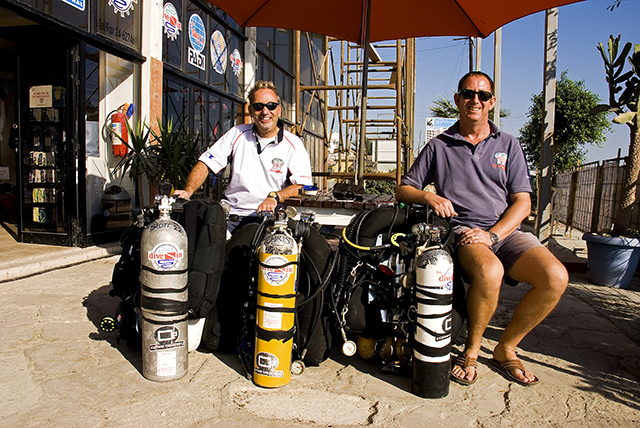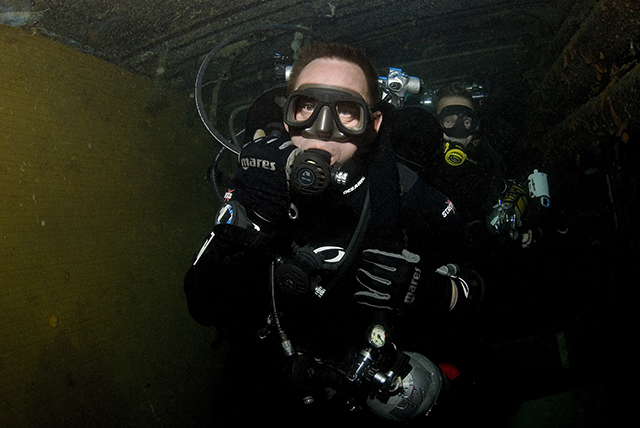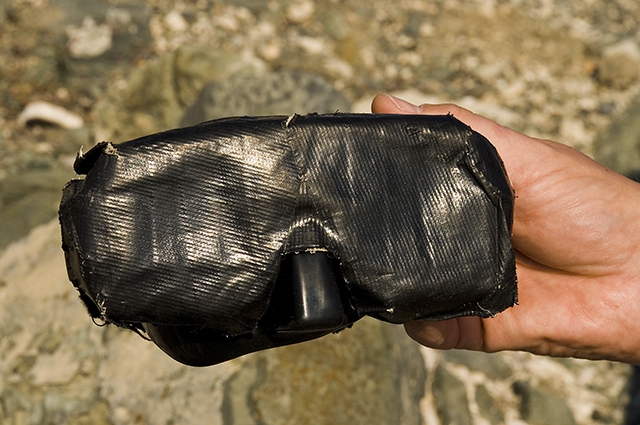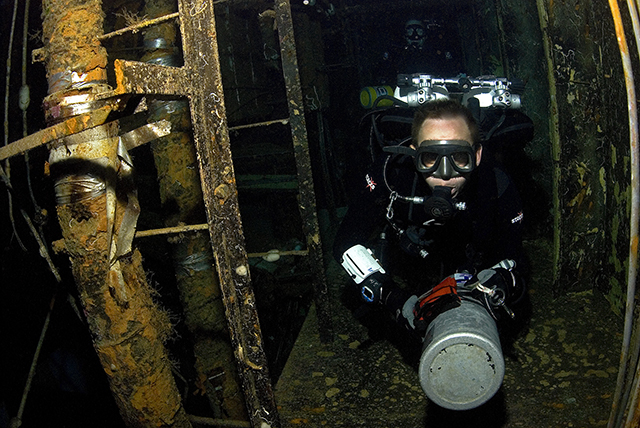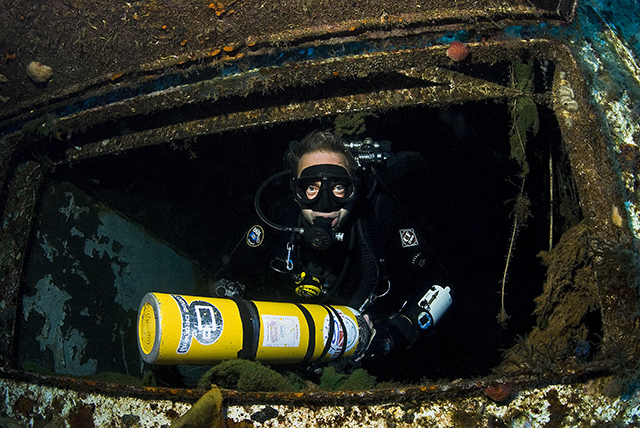Dive Training Blogs
Pitch Black: The TDI Advanced Wreck Diver Course
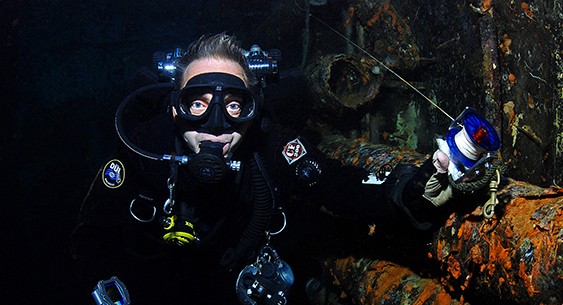
“You’ve just killed everyone,” said Chris Demetriou, the Ops Manager at Dive-In. We had been deep inside the Zenobia, Cyprus’s top wreck site, and sure enough the dive hadn’t gone as planned; but where had I made such a fatal mistake? This was my penultimate dive on the TDI advanced wreck course. The last 3 days had been more psychologically demanding than I had ever imagined. Chris said “I don’t have to load the course with simulated problems, they just happen for real.” He was right; pitch black with no lights and no guidelines, anything could happen – and it usually did!
The Zen is perfect for technical diver training. The 165-metre long ro-ro ferry lies in Larnaca Bay just a few minutes boat ride from the dive centre. Her demise will always be steeped in controversy and intrigue. The most plausible theory is she sank due to a malfunction with the computerised system controlling her ballast tanks. There has never been any salvage operations. Her cargo of 104 articulated lorries and other machinery still lie untouched inside the holds.
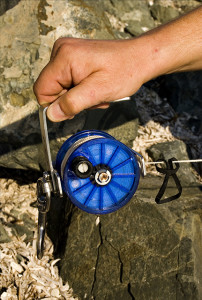
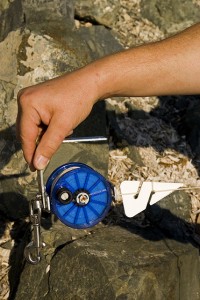 Chris has spent 3 years developing the course itinerary. Most of the training dives are performed in the Officers day room and the Captains bedroom. Although the two rooms are totally enclosed there is plenty of light coming from a row of windows above. Chris explained “you don’t need to go deep inside for the course.” The Zen lies on her port side so doorways, walls and ceilings are not where they are expected to be. Chris said “When planning any penetration dives it’s important to consider room orientation and overall wreck layout.”
Chris has spent 3 years developing the course itinerary. Most of the training dives are performed in the Officers day room and the Captains bedroom. Although the two rooms are totally enclosed there is plenty of light coming from a row of windows above. Chris explained “you don’t need to go deep inside for the course.” The Zen lies on her port side so doorways, walls and ceilings are not where they are expected to be. Chris said “When planning any penetration dives it’s important to consider room orientation and overall wreck layout.”
Although there are some theory sessions, most of the 4-day course concentrates on practical exercises. Ex-Londoner Chris said “this is my favourite TDI course – we’ve run about 10 this year.” He much prefers to teach only two divers per course. Minimum requisites are PADI Advanced diver with the wreck specialty and 50 logged dives or any certifying agency with a wreck familiarisation certificate and the prescribed number of dives. Divers really have to be in the right mind set for this course. Chris said “we don’t have to fail anybody – they fail themselves.” He continued “this course is not for Badge Collectors. By the end of the second day I know if they are going to make it or not.”
My first dive was basically an orientation. This gave me a chance to get familiar with the wreck’s key features and my own equipment configuration. I had been partnered up with Scott Ayrey, an experienced Tri-mix diver. All participants have to wear twin sets with a stage cylinder. Chris prefers to keep his kit as streamlined and as basic as possible: “I don’t want to look like a Christmas tree diver,” he says. There are no cobra heads or cages covering the manifolds or rubber boots and nets on the cylinders. Chris said “it all ends up snagging on the wreck.”
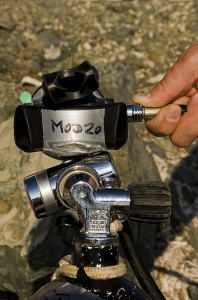 Chris guided us to the bulkhead door that led into the Officers day room. We checked depth and time before entering. Our first task was to draw a map of the entrance and any distinguishing features inside the room. Over the next few dives Scott and I would become quite familiar with the layout. We then performed a number of gas isolation exercises simulating a fractured manifold or a dislodged regulator. A catastrophic gas leak in an enclosed, overhead environment is a real threat. Chris showed us what to do and then it was just a case of following the procedure step by step in a calm co-ordinated manner. All the skills are performed at around 25 metres. There is no need to go any deeper.
Chris guided us to the bulkhead door that led into the Officers day room. We checked depth and time before entering. Our first task was to draw a map of the entrance and any distinguishing features inside the room. Over the next few dives Scott and I would become quite familiar with the layout. We then performed a number of gas isolation exercises simulating a fractured manifold or a dislodged regulator. A catastrophic gas leak in an enclosed, overhead environment is a real threat. Chris showed us what to do and then it was just a case of following the procedure step by step in a calm co-ordinated manner. All the skills are performed at around 25 metres. There is no need to go any deeper.
We stopped during the ascent to switch over to our 50% stage cylinders. Gas switching computers made decompression management a whole lot easier. Permanent marker buoys have been placed at the stern, amidships and bow of the Zen and there is even a trapeze set up at 5 metres to make any stops more comfortable.
The following training dives mainly focused on lost mask procedures, laying/retrieving a guideline and using Scott’s long hose in an out of air scenario. It was well worth spending the first few moments of each exercise gaining composure and thinking about logistics i.e. make sure the long hose is free of any restrictions when air sharing and remembering to keep the line placement as simple and snag free as possible. It also taught me the importance of carrying a back up mask and at least two cutting devices. As Chris had said “it’s the simple things that are life saving.”
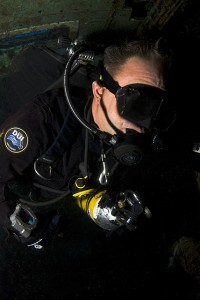 Dive number 4 is probably the toughest of them all. I had to wear Chris’s special blacked-out mask and find my way out of the room by feel alone. It was similar to playing the party game ‘put the tail on the donkey’ but on a much grander scale. Chris spun me around and moved me up and down so I was totally disorientated. There was no guideline this time so my only hope was remembering the room layout and trying to find a familiar object to use as a reference point. My whole sense of perception was left in a severe state of chaos and confusion! I knew from my map that there was a carpet on one side and a row of pipes on the other. My gut reaction was to ascend until I bumped my head on the windows and then move across to a corner where I could hopefully find the carpet. Eventually after 10 minutes of fumbling about my fingers tips felt the familiar texture of woollen fibres. From there on I knew that this would eventually lead to the bulkhead door and freedom! Chris said that the record for escaping was 2-3 minutes but some divers had taken more than an hour to find their way out.
Dive number 4 is probably the toughest of them all. I had to wear Chris’s special blacked-out mask and find my way out of the room by feel alone. It was similar to playing the party game ‘put the tail on the donkey’ but on a much grander scale. Chris spun me around and moved me up and down so I was totally disorientated. There was no guideline this time so my only hope was remembering the room layout and trying to find a familiar object to use as a reference point. My whole sense of perception was left in a severe state of chaos and confusion! I knew from my map that there was a carpet on one side and a row of pipes on the other. My gut reaction was to ascend until I bumped my head on the windows and then move across to a corner where I could hopefully find the carpet. Eventually after 10 minutes of fumbling about my fingers tips felt the familiar texture of woollen fibres. From there on I knew that this would eventually lead to the bulkhead door and freedom! Chris said that the record for escaping was 2-3 minutes but some divers had taken more than an hour to find their way out.
Our last day involved planning and implementing two relatively ‘simple’ wreck penetration dives. Scott and I would enter through the bridge and take it turns to lay the line from the laundry room to the upper car deck. On the way out we would simulate an out of air and a ‘light out’ situation. Chris told us we should always carry a primary light and two back-ups in case of any failure. As I had already found out on Dive 4 having no lights inside a wreck is a nightmare scenario.
Scott was first. He had to lay the guideline. I always thought there would be plenty of pipes, hinges and handles to wrap the line around but it’s not that easy. Chris said that on a previous course one diver had wrapped the line around a floating plastic sheet. This is obviously not a good tie off point for a guideline! Chris had already showed us snoopy loops, line arrows and suitable tie off’s so we were clued up and ready to go.
On the return I was in front using Scott’s long hose. We were in single file along a narrow passageway. It was absolutely pitch black so I slowly and methodically ran my fingers along 10 metres of thin line back to the primary tie off point. Along the way we had to negotiate a tight hatchway and go up and over a doorway. If I moved too fast the regulator would be pulled from my mouth and if I let go of the guideline I would be totally lost. I was 100% dependent on Scott and really didn’t like this feeling of helplessness. We eventually got back to our entry point and completed the training exercise.
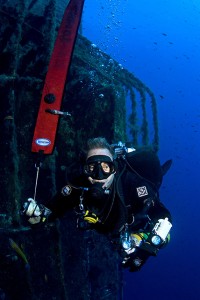
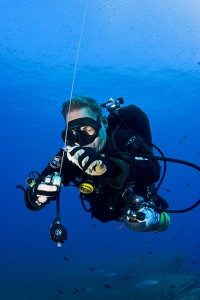 Then it was my turn. This is where my lack of experience laying guidelines really caught me out. There was another guideline already inside the wreck leading off to a different room. I put my primary tie off on the existing line and reeled in from this point. Directional arrows are tied on the line to show the way out but I placed my arrow on the wrong line. This meant we would have got completely lost inside the wreck. Chris said “you won’t make that mistake again.” He was right and this was by far the best way to learn. The more problems we encountered on the course meant it was less likely to occur in real life.
Then it was my turn. This is where my lack of experience laying guidelines really caught me out. There was another guideline already inside the wreck leading off to a different room. I put my primary tie off on the existing line and reeled in from this point. Directional arrows are tied on the line to show the way out but I placed my arrow on the wrong line. This meant we would have got completely lost inside the wreck. Chris said “you won’t make that mistake again.” He was right and this was by far the best way to learn. The more problems we encountered on the course meant it was less likely to occur in real life.
This course gives a whole new meaning to playing around in the dark! Although it was a tough 4 days I enjoyed every moment. We started off with the basics and worked our way up to some heavy task loading exercises. Chris made sure we had a thorough de-briefing after each dive. This gave us a chance to sit down and discuss any problems and go over remedial actions. I soon realised that it’s essential to keep a cool head. It also pushed home the fact that my buddy had to be just as level headed. I was lucky to have Scott as my partner. All I can say is choose wisely! Chris said “Panic will kill you all day long; the key is to never give up.” All of the skills were performed in a ‘controlled’ environment and Chris was always close at hand if any real problems had occurred. Although I had completed all the training exercises I still couldn’t stop thinking how would I react in a real life situation? Pitch-black, deep inside the wreck, no guidelines and no buddy… what would I do?
Information
Contact Dive-In for more information on package prices including B&B accommodation at the 2-Star San Remo Hotel, located behind the dive centre.
Blogs
Jeff Goodman Launches Underwater Moviemaker Course with NovoScuba

Transform Your Dive Experiences into Cinematic Masterpieces
NovoScuba has partnered with acclaimed underwater filmmaker Jeff Goodman to introduce the Underwater Moviemaker Course—a revolutionary program designed to equip divers with the skills to capture the breathtaking beauty of the underwater world.
Whether you’re an aspiring filmmaker, an avid diver, or a photography enthusiast, this course offers the tools and expertise needed to create stunning underwater videos. From vibrant coral reefs to curious marine life, you’ll learn how to film, edit, and produce captivating underwater stories, all with expert guidance from a seasoned professional.
Jeff Goodman: A Legacy in Underwater Filmmaking
Jeff Goodman brings over 40 years of experience in underwater film production for television to this course. Reflecting on his career, Jeff said:
“Although technology has dramatically changed, the basics of underwater filming remain constant. This course covers crucial skills for producing great videos. Whether you’re creating professional broadcast films or high-quality hobby videos, the fundamental principles are the same.
A camera operator must master their equipment to capture those magical underwater moments effortlessly. But beyond technical know-how, underwater filmmaking is about having fun and enhancing your diving experiences. So, take your time, learn at your own pace, and enjoy this creative journey.”
About NovoScuba
Founded in 2023, NovoScuba is reshaping dive education with a comprehensive, digitally native platform. Offering cutting-edge training programs for divers at all levels, NovoScuba sets a new benchmark in the diving industry by combining innovation with accessibility.
With ISO-certified courses, a student subscription model, and multilingual support, NovoScuba ensures that dive education is inclusive and engaging. More than just a training provider, NovoScuba fosters a global community of divers committed to exploration, collaboration, and sustainability.
Join the NovoScuba Underwater Moviemaker Course Today!
Dive into the world of underwater filmmaking and start creating cinematic stories that inspire. Learn more about the course and enroll today at www.novoscuba.com/novoscuba-underwater-moviemaker-course.
EXCLUSIVE: Jeff Goodman interviews Mark Spiers, CEO of New Scuba Diving Training Agency NovoScuba
NovoScuba’s Game-Changing Approach for Dive Store Owners: WE PAY YOU!
The diving world thrives on passion and adventure, but for many dive store owners, the financial and operational challenges can be as deep as the ocean.
NovoScuba, an emerging force in the diving world, is on a mission to transform this landscape for the better. With a revolutionary approach to dive store and training agency partnerships, NovoScuba is setting new standards for how dive stores can thrive while keeping their focus on delivering exceptional diving experiences.

A New Paradigm: NovoScuba’s Bold Mission
NovoScuba’s mission is straightforward yet profound: to disrupt the traditional dynamics between dive store owners and training agencies. Traditionally, dive stores have been subjected to substantial fees charged by training agencies, for membership, materials and certifications. These costs have often placed a heavy financial burden on store owners, cutting into their profits and limiting their ability to offer competitive prices to customers.
NovoScuba flips the script by offering a model where dive stores earn money, instead of paying high fees. Dive stores receive commissions for every student they register, and their certification costs are covered. This new model not only boosts profitability but also ensures clients get top-quality training at unbeatable prices.
Financial Upsides: Earn From Student Registration
NovoScuba’s approach is simple yet revolutionary. Dive stores partnering with NovoScuba can earn commissions for every student they enroll.
Here’s how it works: For every student enrolled through NovoScuba, dive stores receive a commission. Each student enrolled will receive their e-learning materials and certification credit included in their subscription. This arrangement is a significant departure from the traditional model, where dive stores often struggle to manage high overhead costs related to training fees and certification expenses.

NovoScuba’s approach ensures that dive stores can focus on what they do best—providing top-notch diving experiences—without being bogged down by excessive financial burdens, and the need to carry large stocks of materials.
Quality Training at a Great Price
NovoScuba stands out by offering high-quality, ISO certified, training that doesn’t break the bank, in fact our students will pay less than with most competing agencies. Clients benefit from top-notch education and safety standards at competitive prices. Dive store owners can confidently promote NovoScuba’s programs, knowing they’re offering fantastic training at affordable rates. This balance of quality and affordability helps dive stores build a strong reputation and attract more customers.
Your Brand is Your Business: NovoScuba’s Commitment to Showcasing Your Identity
At NovoScuba, we understand that your brand is your most valuable asset, and we’re committed to putting it front and centre. Unlike agencies that charge high fees to promote their own brand, we believe in investing in yours. With NovoScuba, you won’t be paying to advertise someone else’s logo alone, — our focus is on showcasing your unique identity. Certifications prominently feature your brand, as well as the training agency, reinforcing your store’s image and brand every step of the way. We’re here to support and elevate your brand, ensuring that your investment directly benefits your business.
Affordable Membership: An Investment in Your Success
NovoScuba’s membership model is designed with dive store owners in mind. Membership fees are kept low and include annual Pro member fees for your team. Payment can be made monthly or annually in your local currency, avoiding the hassle of exchange rate fluctuations. NovoScuba promises no exchange rate changes without a six-month notice, ensuring financial stability and simplifying budgeting. With a membership lasting 12 months from date of joining, you’ll enjoy a full year of NovoScuba’s benefits and support.

Streamlined Operations: Simplifying Your Workload
Handling administrative tasks can be a challenge, but NovoScuba makes it easier. We’ve streamlined certification procedures and reduced paperwork to help dive stores operate more efficiently. Certification processing is quick and straightforward, allowing more focus on teaching and customer service. Our system minimises bureaucracy by storing necessary forms in student profiles, reducing paperwork and administrative delays.
Crossover Made Easy
For dive stores looking to transition to NovoScuba’s model, the crossover process is designed to be smooth and hassle-free. NovoScuba provides support to ensure that the transition is as seamless as possible, helping dive store owners integrate into the new system with minimal disruption. Experienced dive Pros don’t need to undergo extensive retraining. Our crossover is designed to familiarise Pros with NovoScuba’s user-friendly platform, standards and course structures, and not to waste time and expense re-training in water.
With just a few simple steps, you’ll be ready to offer top-notch training through NovoScuba.
Comprehensive Business Support and Training Included in Your Membership
NovoScuba goes beyond financial benefits by offering experienced support and training. This value added service includes:
- Business Training: Optimise your operations with guidance on marketing, customer service, and best practices.
- Marketing and Promotion: Access resources to attract new customers and boost your store’s visibility. Enjoy cross promotions with NovoScuba to gain increased exposure.
- Ongoing Support: NovoScuba’s commitment to its partners extends beyond initial training and setup. The company offers ongoing support to address any issues or questions that arise. This continuous support ensures that dive store owners have a reliable resource to turn to whenever they need assistance.

Embracing Digital Natives: Instant Evolution and Continuous Improvement
NovoScuba’s digital-native approach is a game-changer. Leveraging cutting-edge technology, we ensure our services evolve and improve swiftly. Dive stores benefit from instant updates, the latest features, enhancements, and effective solutions, keeping them ahead of the curve. This continuous improvement helps dive stores stay competitive and deliver exceptional services. Whether it’s a new course update, additional marketing resources, or improved e-learning functions, NovoScuba’s digital infrastructure ensures that dive stores are always equipped with the most current and effective solutions. This continuous evolution not only helps dive stores stay ahead in a competitive market but also ensures they consistently provide top-quality services to their clients.
Why Is NovoScuba Doing This? – Fair Profit Sharing for Greater Access and Growth
At NovoScuba, we’ve taken a bold step by paying commissions to stores rather than following the traditional model of training agencies charging high fees. Our mission is to make diving accessible to everyone and to foster a growing community of new divers and continued education. By redistributing profits more equitably between stores and training agencies, we aim to create a more supportive and collaborative environment within the industry. We believe this approach not only helps individual stores thrive but also stimulates overall growth and innovation in diving. Our commitment to fair profit sharing reflects our dedication to the long-term health and expansion of the diving community.

Everyone is getting a piece of the pie.
Getting Started: Join the NovoScuba Revolution
Ready to revolutionise your dive store experience? NovoScuba is here to support your journey toward reduced costs, increased profitability, and enhanced operational efficiency. Get in touch with our team to learn how NovoScuba can transform your business.
For more information, email info@novoscuba.com or visit www.novoscuba.academy.
Blogs
NovoScuba’s Game-Changing Approach for Dive Store Owners: WE PAY YOU!

 The diving world thrives on passion and adventure, but for many dive store owners, the financial and operational challenges can be as deep as the ocean.
The diving world thrives on passion and adventure, but for many dive store owners, the financial and operational challenges can be as deep as the ocean.
NovoScuba, an emerging force in the diving world, is on a mission to transform this landscape for the better. With a revolutionary approach to dive store and training agency partnerships, NovoScuba is setting new standards for how dive stores can thrive while keeping their focus on delivering exceptional diving experiences.

A New Paradigm: NovoScuba’s Bold Mission
NovoScuba’s mission is straightforward yet profound: to disrupt the traditional dynamics between dive store owners and training agencies. Traditionally, dive stores have been subjected to substantial fees charged by training agencies, for membership, materials and certifications. These costs have often placed a heavy financial burden on store owners, cutting into their profits and limiting their ability to offer competitive prices to customers.
NovoScuba flips the script by offering a model where dive stores earn money, instead of paying high fees. Dive stores receive commissions for every student they register, and their certification costs are covered. This new model not only boosts profitability but also ensures clients get top-quality training at unbeatable prices.
Financial Upsides: Earn From Student Registration
NovoScuba’s approach is simple yet revolutionary. Dive stores partnering with NovoScuba can earn commissions for every student they enroll.
Here’s how it works: For every student enrolled through NovoScuba, dive stores receive a commission. Each student enrolled will receive their e-learning materials and certification credit included in their subscription. This arrangement is a significant departure from the traditional model, where dive stores often struggle to manage high overhead costs related to training fees and certification expenses.

NovoScuba’s approach ensures that dive stores can focus on what they do best—providing top-notch diving experiences—without being bogged down by excessive financial burdens, and the need to carry large stocks of materials.
Quality Training at a Great Price
NovoScuba stands out by offering high-quality, ISO certified, training that doesn’t break the bank, in fact our students will pay less than with most competing agencies. Clients benefit from top-notch education and safety standards at competitive prices. Dive store owners can confidently promote NovoScuba’s programs, knowing they’re offering fantastic training at affordable rates. This balance of quality and affordability helps dive stores build a strong reputation and attract more customers.
Your Brand is Your Business: NovoScuba’s Commitment to Showcasing Your Identity
At NovoScuba, we understand that your brand is your most valuable asset, and we’re committed to putting it front and centre. Unlike agencies that charge high fees to promote their own brand, we believe in investing in yours. With NovoScuba, you won’t be paying to advertise someone else’s logo alone, — our focus is on showcasing your unique identity. Certifications prominently feature your brand, as well as the training agency, reinforcing your store’s image and brand every step of the way. We’re here to support and elevate your brand, ensuring that your investment directly benefits your business.
Affordable Membership: An Investment in Your Success
NovoScuba’s membership model is designed with dive store owners in mind. Membership fees are kept low and include annual Pro member fees for your team. Payment can be made monthly or annually in your local currency, avoiding the hassle of exchange rate fluctuations. NovoScuba promises no exchange rate changes without a six-month notice, ensuring financial stability and simplifying budgeting. With a membership lasting 12 months from date of joining, you’ll enjoy a full year of NovoScuba’s benefits and support.

Streamlined Operations: Simplifying Your Workload
Handling administrative tasks can be a challenge, but NovoScuba makes it easier. We’ve streamlined certification procedures and reduced paperwork to help dive stores operate more efficiently. Certification processing is quick and straightforward, allowing more focus on teaching and customer service. Our system minimises bureaucracy by storing necessary forms in student profiles, reducing paperwork and administrative delays.
Crossover Made Easy
For dive stores looking to transition to NovoScuba’s model, the crossover process is designed to be smooth and hassle-free. NovoScuba provides support to ensure that the transition is as seamless as possible, helping dive store owners integrate into the new system with minimal disruption. Experienced dive Pros don’t need to undergo extensive retraining. Our crossover is designed to familiarise Pros with NovoScuba’s user-friendly platform, standards and course structures, and not to waste time and expense re-training in water.
With just a few simple steps, you’ll be ready to offer top-notch training through NovoScuba.
Comprehensive Business Support and Training Included in Your Membership
NovoScuba goes beyond financial benefits by offering experienced support and training. This value added service includes:
- Business Training: Optimise your operations with guidance on marketing, customer service, and best practices.
- Marketing and Promotion: Access resources to attract new customers and boost your store’s visibility. Enjoy cross promotions with NovoScuba to gain increased exposure.
- Ongoing Support: NovoScuba’s commitment to its partners extends beyond initial training and setup. The company offers ongoing support to address any issues or questions that arise. This continuous support ensures that dive store owners have a reliable resource to turn to whenever they need assistance.
Embracing Digital Natives: Instant Evolution and Continuous Improvement
NovoScuba’s digital-native approach is a game-changer. Leveraging cutting-edge technology, we ensure our services evolve and improve swiftly. Dive stores benefit from instant updates, the latest features, enhancements, and effective solutions, keeping them ahead of the curve. This continuous improvement helps dive stores stay competitive and deliver exceptional services. Whether it’s a new course update, additional marketing resources, or improved e-learning functions, NovoScuba’s digital infrastructure ensures that dive stores are always equipped with the most current and effective solutions. This continuous evolution not only helps dive stores stay ahead in a competitive market but also ensures they consistently provide top-quality services to their clients.
Why Is NovoScuba Doing This? – Fair Profit Sharing for Greater Access and Growth
At NovoScuba, we’ve taken a bold step by paying commissions to stores rather than following the traditional model of training agencies charging high fees. Our mission is to make diving accessible to everyone and to foster a growing community of new divers and continued education. By redistributing profits more equitably between stores and training agencies, we aim to create a more supportive and collaborative environment within the industry. We believe this approach not only helps individual stores thrive but also stimulates overall growth and innovation in diving. Our commitment to fair profit sharing reflects our dedication to the long-term health and expansion of the diving community.

Everyone is getting a piece of the pie.
Getting Started: Join the NovoScuba Revolution
Ready to revolutionise your dive store experience? NovoScuba is here to support your journey toward reduced costs, increased profitability, and enhanced operational efficiency. Get in touch with our team to learn how NovoScuba can transform your business.
For more information, email info@novoscuba.com or visit www.novoscuba.academy.
-

 News2 months ago
News2 months agoIconic SS United States to become the World’s Largest Artificial Reef
-

 News3 months ago
News3 months agoBook Review – 52 Assignments: Underwater Photography
-

 Gear News3 months ago
Gear News3 months agoDYNAMICNORD – New German diving brand enters the British market
-

 News3 months ago
News3 months agoExploring Cenote El Pit: A Diver’s Dream
-

 Gear News3 months ago
Gear News3 months agoTry BARE drysuits (and maybe even win one!) this Friday with Sea & Sea at North West Dive Fest
-

 Marine Life & Conservation3 months ago
Marine Life & Conservation3 months agoBook Review: Coral Triangle Cameos
-

 Blogs2 months ago
Blogs2 months agoDive the Egyptian Red Sea this Autumn with Regaldive
-

 News3 months ago
News3 months ago2024 Ocean Art Underwater Photo Competition Announced


